Part III: Resources
Alliance for Excellent Education
This website includes easy to use information about ESSA plans in every state.
https://all4ed.org/issues/
Beyond the Bake Sale: A Checklist to Determine How Well is Your School Bridging Racial, Class and Cultural Differences
http://www.sfusd.edu/en/assets/sfusd-staff/Racial%20Class%20&%20Cultural%20Differences.pdf
Family Engagement Toolkit, California DOE
IDEA State Advisory Panels (SAP) and State Interagency Coordinating Councils
Minority Parent and Community Engagement: Best Practices and Policy Recommendations for Closing the Gaps in Student Achievement
http://www.maldef.org/assets/pdf/MCO_MALDEF%20Report_final.pdf
National Center for Family and Community Connection with Schools
National PTA Standards for Family-School Partnerships
Parent Center Hub
The Center for Parent Information and Resources maintains a list of the OSEP-funded Parent Training and Information Centers and Community Parent Resources Centers serving families of children with disabilities in every state and U.S. territory.
https://www.parentcenterhub.org/?s=family+engagement
Parent Engagement Toolkit and Family Matters
https://www.michigan.gov/mde/0,4615,7-140-6598_88187_81739-425428–,00.html
Partners in Education: A Dual Capacity-Building Framework for Family-School Partnerships (PDF)
http://www2.ed.gov/documents/family-community/partners-education.pdf
Research on Parent Involvement with Diverse Families
http://www.pacer.org/cultural-diversity/research-literature.asp
Robert’s Rules of Order
Serving on Groups
Signetwork Family Engagement Resources
A virtual library of curated resources on topics in family engagement, including on Building Partnerships.
http://signetwork.org/content_pages/184-family-engagement#building
The World Café
The World Café is a structured conversational process intended to facilitate open and intimate discussion, and link ideas within a larger group to access ‘collective intelligence’ or collective insight.
http://www.theworldcafe.com/
Tips for Administrators, Teachers, and Families: How to Share Data Effectively
Part III: Resources
Our Process
We used a three-pronged effort to develop Section III of this guide. This was not a comprehensive research effort, but rather, an effort to gather qualitative information from Parent Center leaders about activity in their state and their efforts to support local SEPACs.
- Survey — We surveyed more than 400 Parent Center leaders and staff to learn more about interests and priorities for this guide and ways in which Parent Centers interface with and support parents as advisors, whether on SEPAC or other groups. Their candid responses gave us a starting point for this guide. Scores of respondents indicated a willingness to take part in a phone interview, allowing our team to drill down and get more details about state activities.
- Interviews — Based on the survey results, the project team carried out detailed interviews with leaders at Parent Centers across the country in those states where SEPACs are present at the local or intermediate unit level. 19 Leaders from 14 states responded to our requests, and shared their views, experiences and perspectives.
- Research — With guidance from state-level leaders, the team looked at enabling state legislation, as well as rules and regulations to implement that legislation (where it exists) to find common threads and look for trends, themes and best practice. We asked parent leaders to send us copies of guides, videos, power point and other training and informational materials so we could review the content and learn more about what is happening on the ground.
Part III: Resources
- Identify SEPAC Mission, purpose and function.
- Determine the role of the Special Education Director.
- Create a diverse membership.
- Build Stakeholder representation.
- Establish operating procedures (bylaws, norms).
- Hold orientation/planning meeting.
- Advertise and promote meetings.
- Set priorities.
- Establish communication and consensus-building strategies.
- Determine annual activities and projects.
- Review annual accomplishments and decide on next steps.
Download this and other resource forms and worksheets as PDF.
Download this and other resource forms and worksheets as MSWord.
Adapted from ‘A Guide for Local Special Education Advisory Committees in Colorado,’ © 2010 produced by the Colorado Special Education Advisory Committee (CSEAC) and Colorado Department of Education, http://www.cde.state.co.us/cdesped/CSEAC.asp (303) 866-6943.
Part III: Resources
Tools for Change
Sample SEPAC Job Description
This position has primary responsibility for working with other SEPAC members to fulfill the following functions outlined:
- Advise the local school district of needs in the education of children with disabilities.
- Participate in the development of priorities and strategies for meeting the identified needs of children with disabilities.
- Submit periodic reports and recommendations regarding the education of children with disabilities to the division superintendent for transmission to the local school board.
- Assist the local school district in interpreting plans to the community for meeting the special needs of children with disabilities for educational services.
- Review the policies and procedures for the provision of special education and related services prior to submission to the local school board.
- Participate in the review of the local school district’s annual plan.
Individuals in this position work closely with the local director of special education. Other responsibilities include:
- Review and abide by SEPAC bylaws.
- Attend regularly scheduled local SEPAC meetings.
- Maintain an ongoing knowledge of special education law.
- Be informed of activities of the committee and familiar with current school division special education plans.
- Read the minutes of each meeting; advise the chair of any corrections or additions.
- Participate in the work of the SEPAC, including serving on subcommittees when required.
- Encourage parents and other community members to join/attend the SEPAC.
- Participate in community awareness activities to increase visibility of the local SEPAC.
- Focus on systems change, not personal grievances or individual advocacy.
- Work collaboratively with other SEPAC members and school division leadership and personnel.
Download this and other resource forms and worksheets as PDF.
Download this and other resource forms and worksheets as MSWord.
Adapted from ‘A Guide for Local Special Education Advisory Committees in Virginia,’ © 2011. Used with permission from the Center
for Family Involvement at the Partnership for People with Disabilities at the Virginia Commonwealth University. 804-828-3876. All rights reserved. http://www.doe.virginia.gov/boe/committees_advisory/special_ed/local_sped_advisory_committees/index.shtml
Part III: Resources
Tools for Change
Sample SEPAC Mission Statements
- Our mission is to facilitate communication between students, parents, community members, administrators, and the Board of Education, for the purpose of improving the quality of district-wide special education policies, programs, and practices. The (district name) SEPAC offers the opportunity to raise questions, to voice your concerns, and to provide direct input to administrators regarding Special Services and the Board of Education.
- The mission of the (district name) Special Education Parental Advisory Council (SEPAC) is to encourage honest and effective communication, understanding, and mutual respect in a supportive partnership inclusive of all students, parents, educators, and the community at large in an effort to ensure the delivery of appropriate services to students with disabilities
- The (district name) Special Education Parent Advisory Council (SEPAC) is a district-wide volunteer organization. We offer advice, provide information, and make available resources to parents of children with special educational needs. We work closely with the (district name) Child Study Team to identify areas of need from (grade levels). We are parents of children with learning differences and we are willing to share our experience and information with you. The (district name) SEPAC is a supportive, informative, and encouraging forum for you and your child. It is our goal to empower you, the parent, to become an effective advocate for your child.
- The mission of the (district name) SEPAC is to facilitate collaboration between students, parents, staff, the Board of Education, and the community in order to promote inclusion, understanding of, respect for, and support of all children with special needs in our community.
Download this and other resource forms and worksheets as PDF.
Download this and other resource forms and worksheets as MSWord.
From ‘Special Education Parent Advisory Groups in New Jersey,’ © 2017. Used with permission from SPAN Advocacy, Inc., Newark, NJ , (800) 654-SPAN. http://www.spanadvocacy.org/. All rights reserved.
Part III: Resources
Tools for Change
Sample Copy for a Flyer
SEPAC’s role:
- To provide direct input on the policies, programs, and practices that affect services and supports for students with disabilities.
- To increase the involvement of families of children with special needs.
- To advise on issues that affect the education, health, and safety of students with special needs.
Who should attend a SEPAC meeting?
- Anyone in the district with a student or students with disabilities.
- Anyone with a student or students eligible for or receiving services under an IEP or 504 plan.
Who should attend a SEPAC meeting?
- Concerns related to a group of students are shared and discussed.
- District representatives provide updates related to special services in the school district and at the state and national levels.
- Parents have adequate time to discuss issues among themselves and plan the agenda for the next meeting.
- Speakers, other district leaders, and individual staff members may be invited, based upon requests from the SEPAC.
What else can a member of the SEPAC do to advance the mission?
- Volunteer to be a parent representative regarding issues and concerns raised at your individual school.
- Remember that SEPAC meetings are not the forum for a discussion about individual students or a child’s IEP. Topics are limited to those which impact all students or a group of students. Additionally, these meetings are for parents only. It is not appropriate to have your child attend these meetings.
Sample SEPAC Bylaws
The SEPAC will provide input and make recommendations on special education policy, programs, and practices to the district.
SEPAC members will act as liaisons to share comments and concerns with school leaders.
A secretary will be appointed to coordinate activities, attend meetings, and take minutes at SEPAC meetings. Meeting minutes and an agenda will be distributed prior to all meetings.
Meetings will be held at a variety of times and locations and will be announced on the SEPAC website. Notices will be available in every school and will be distributed to parents, including those in out-of-district placements, via print and email.
Principals, PTO Presidents, and Child Study Teams will assist in identifying parents who may want to be part of the SEPAC.
Robert’s Rules of Order, Newly Revised shall govern all meetings in all cases in which they are applicable, and in which they are not in conflict with these bylaws.
The SEPAC will work to ensure that membership reflects the linguistic, religious, racial, cultural and socio-economic diversity of the local school community and includes members from each preschool, elementary school, middle school, and high school, as well as at least one parent of a student receiving services out-of-district.
Download this and other resource forms and worksheets as PDF.
Download this and other resource forms and worksheets as MSWord.
From ‘Special Education Parent Advisory Groups in New Jersey,’ © 2017. Used with permission from SPAN Advocacy, Inc., Newark, NJ ,
(800) 654-SPAN. http://www.spanadvocacy.org/. All rights reserved.
Part III: Resources
Tools for Change
Sample Action Sheet – Agenda and Minutes
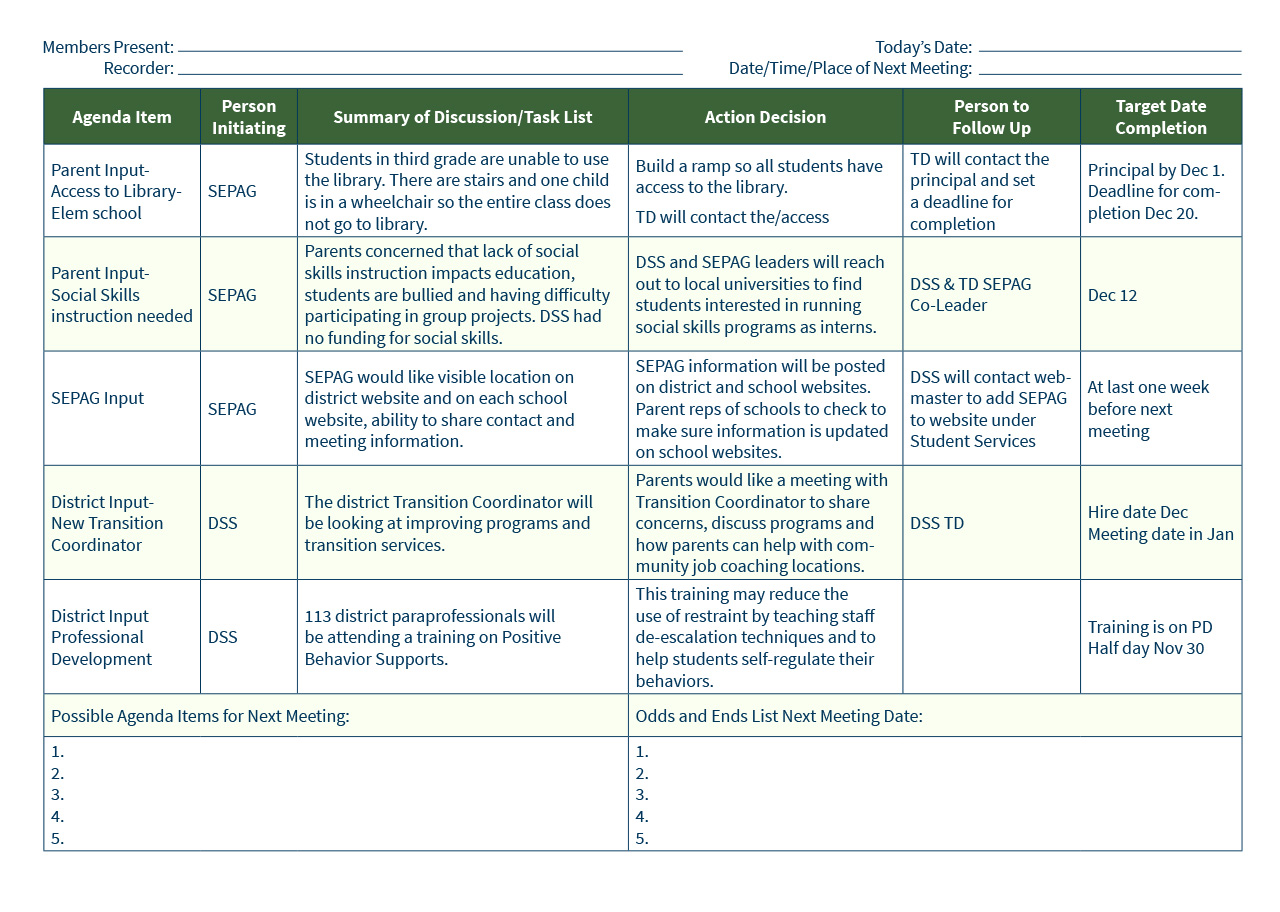
From ‘Special Education Parent Advisory Groups in New Jersey,’ © 2017. Used with permission from SPAN Advocacy, Inc., Newark, NJ , (800) 654-SPAN. http://www.spanadvocacy.org/. All rights reserved.
Part III: Resources
Tools for Change
SEPAC Input Form
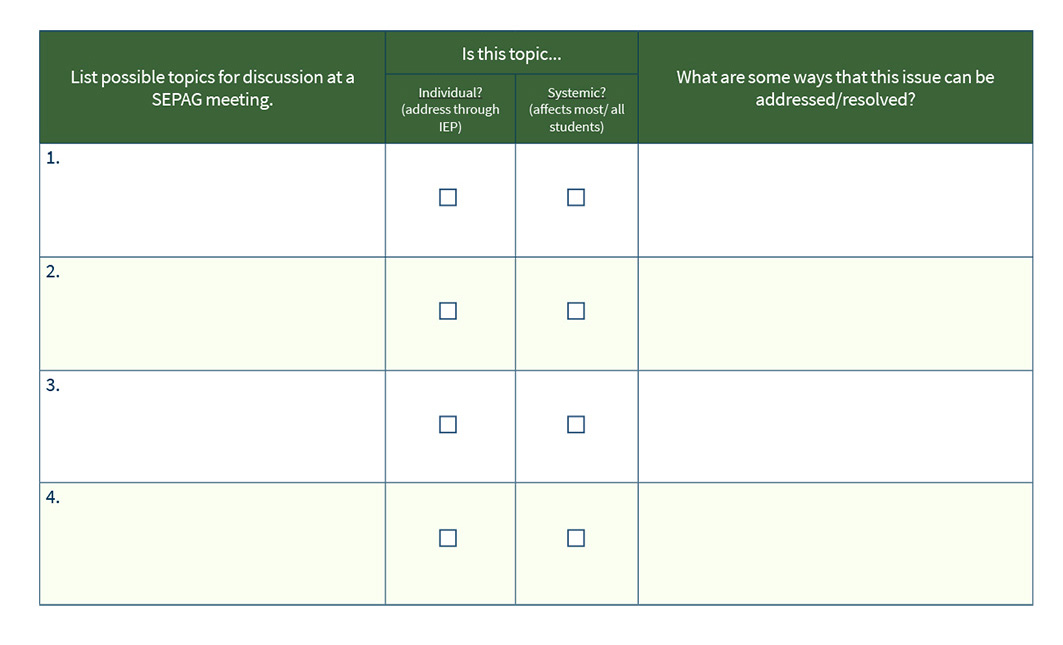
From ‘Special Education Parent Advisory Groups in New Jersey,’ © 2017. Used with permission from SPAN Advocacy, Inc., Newark, NJ , (800) 654-SPAN. http://www.spanadvocacy.org/. All rights reserved.
Part III: Resources
Tools for Change
SEPAC Workshop Reflection
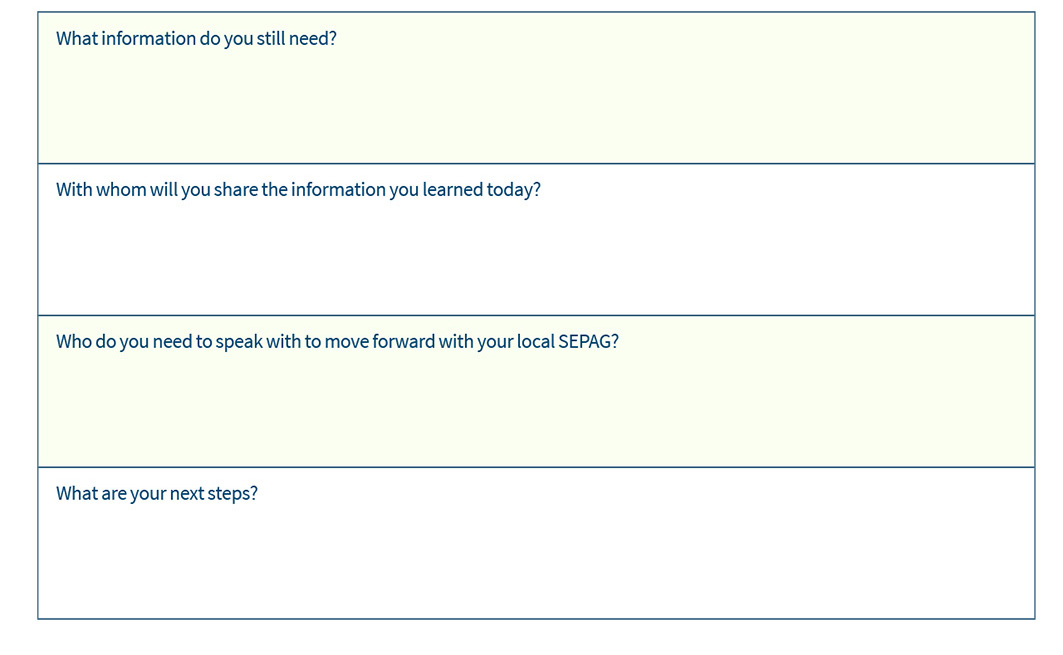
From ‘Special Education Parent Advisory Groups in New Jersey,’ © 2017. Used with permission from SPAN Advocacy, Inc., Newark, NJ , (800) 654-SPAN. http://www.spanadvocacy.org/. All rights reserved.
Part III: Resources
Tools for Change
Next Steps: Action Planning Worksheet
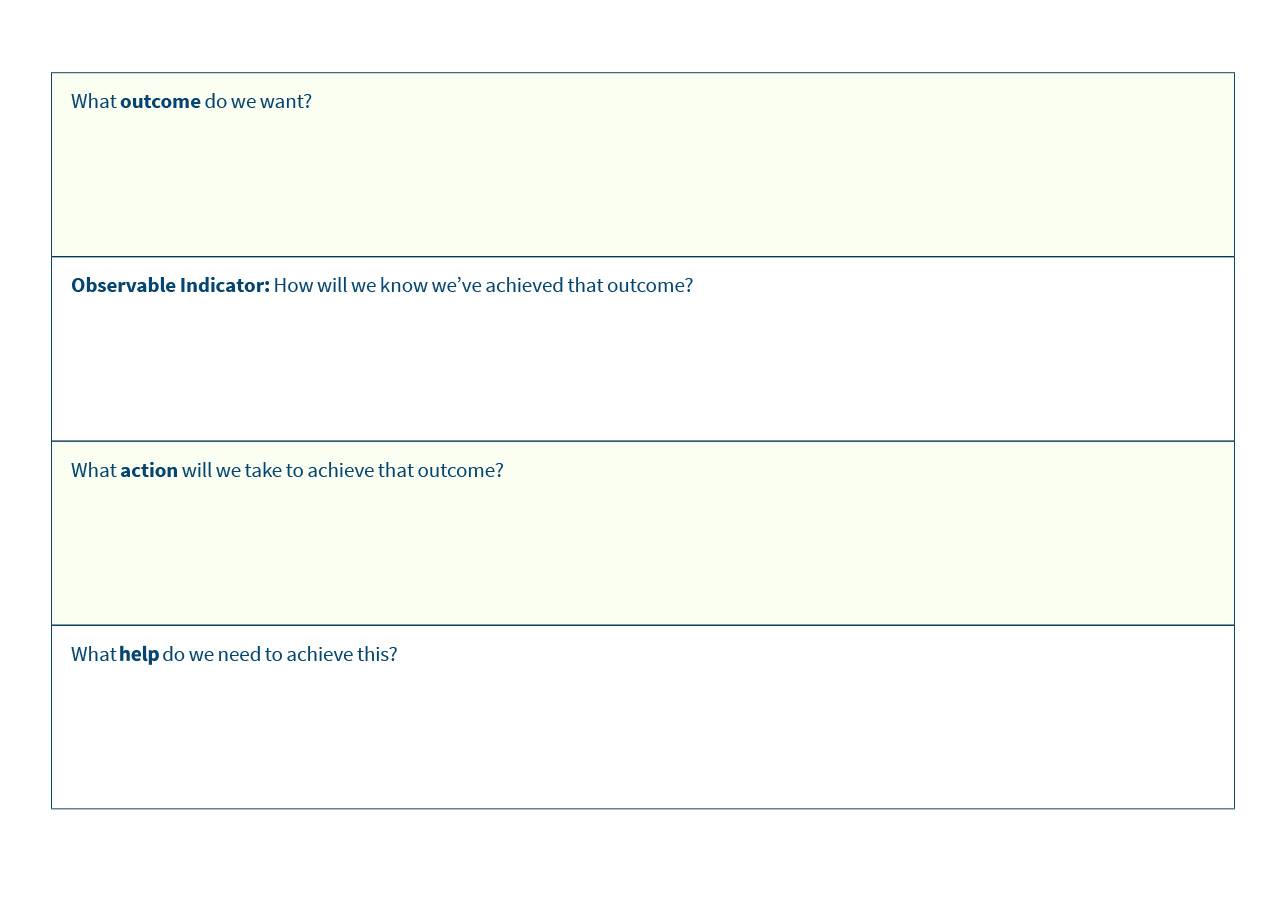
From ‘A Guide for Minnesota Local Special Education Advisory Councils,’ © 2011. Used with permission from PACER Center, Inc., Minneapolis, MN, (952) 838-9000. http://www.pacer.org. All rights reserved.
Part III: Resources
Tools for Change
Sample SEPAC Self-Assessment
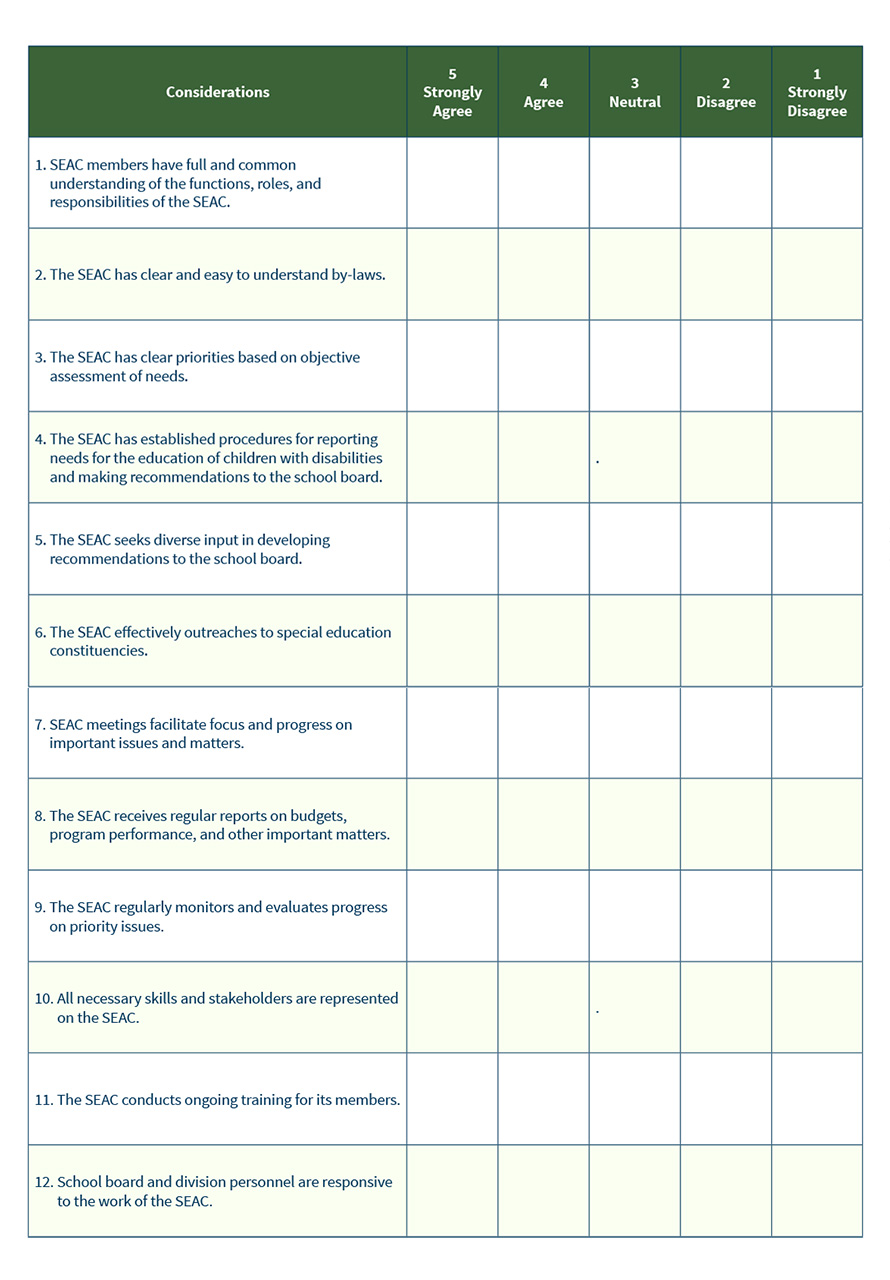
From ‘A Guide for Local Special Education Advisory Committees in Virginia,’ © 2011. Used with permission from the Center for Family Involvement at the Partnership for People with Disabilities at the Virginia Commonwealth University. 804-828-3876. All rights reserved.
http://www.doe.virginia.gov/boe/committees_advisory/special_ed/local_sped_advisory_committees/index.shtml